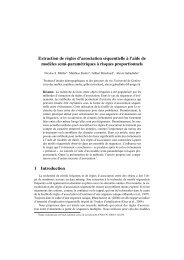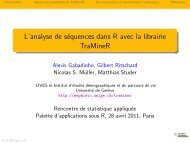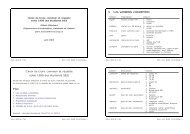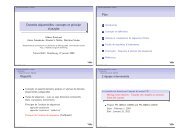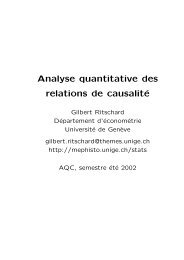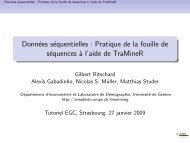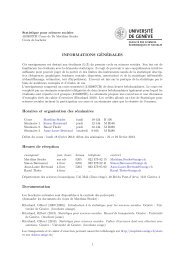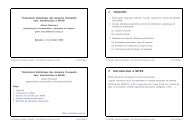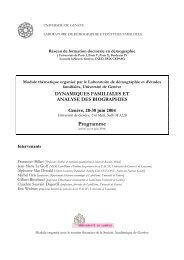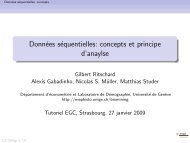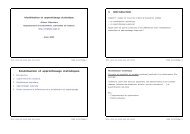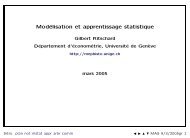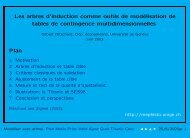L'analyse de séquence dans R avec la librairie TraMineR Outline ...
L'analyse de séquence dans R avec la librairie TraMineR Outline ...
L'analyse de séquence dans R avec la librairie TraMineR Outline ...
- No tags were found...
You also want an ePaper? Increase the reach of your titles
YUMPU automatically turns print PDFs into web optimized ePapers that Google loves.
Introduction Aperçu <strong>de</strong>s possibilités <strong>de</strong> <strong>TraMineR</strong> Documentation et communauté d’utilisateurs RéférencesIntroduction Aperçu <strong>de</strong>s possibilités <strong>de</strong> <strong>TraMineR</strong> Documentation et communauté d’utilisateurs RéférencesReferences IMerci!Abbott, A. (1997). Optimize. http://home.uchicago.edu/˜aabbott/om.html.Abbott, A. (2001). Time Matters. On Theory and Methods. Chicago: ChicagoPress.Berchtold, A. and A. Berchtold (2004). MARCH 2.02: Markovian mo<strong>de</strong>lcomputation and analysis. User’s gui<strong>de</strong>.Brzinsky-Fay, C., U. Kohler, and M. Luniak (2006). Sequence analysis withStata. The Stata Journal 6(4), 435–460.Elzinga, C. H. (2007). CHESA 2.1 User manual. User gui<strong>de</strong>, Dept of SocialScience Research Methods, Vrije Universiteit, Amsterdam.Gabadinho, A., G. Ritschard, N. S. Müller, and M. Stu<strong>de</strong>r (2011). Analyzingand visualizing state sequences in R with <strong>TraMineR</strong>. Journal of StatisticalSoftware 40(4), 1–37.Gabadinho, A., G. Ritschard, M. Stu<strong>de</strong>r, and N. S. Müller (2009). Miningsequence data in R with the <strong>TraMineR</strong> package: A user’s gui<strong>de</strong>. Technicalreport, Department of Econometrics and Laboratory of Demography,University of Geneva, Geneva.28/4/2011gr 23/2528/4/2011gr 24/25Introduction Aperçu <strong>de</strong>s possibilités <strong>de</strong> <strong>TraMineR</strong> Documentation et communauté d’utilisateurs RéférencesReferences II28/4/2011gr 25/25Gabadinho, A., G. Ritschard, M. Stu<strong>de</strong>r, and N. S. Müller (2011). Extractingand ren<strong>de</strong>ring representative sequences. In A. Fred, J. L. G. Dietz, K. Liu,and J. Filipe (Eds.), Knowledge Discovery, Knowledge Engineering andKnowledge Management, Volume 128 of Communications in Computer andInformation Science (CCIS), pp. 94–106. Springer-Ver<strong>la</strong>g.McVicar, D. and M. Anyadike-Danes (2002). Predicting successful andunsuccessful transitions from school to work using sequence methods.Journal of the Royal Statistical Society A 165(2), 317–334.Ritschard, G., A. Gabadinho, N. S. Müller, and M. Stu<strong>de</strong>r (2008). Miningevent histories: A social science perspective. International Journal of DataMining, Mo<strong>de</strong>lling and Management 1(1), 68–90.Rohwer, G. and U. Pötter (2002). TDA user’s manual. Software,Ruhr-Universität Bochum, Fakultät für Sozialwissenschaften, Bochum.Stu<strong>de</strong>r, M., G. Ritschard, A. Gabadinho, et N. S. Müller (2009). Analyse <strong>de</strong>dissimi<strong>la</strong>rités par arbre d’induction. Revue <strong>de</strong>s nouvelles technologies <strong>de</strong>l’information RNTI E-15, 7–18.Stu<strong>de</strong>r, M., G. Ritschard, A. Gabadinho, et N. S. Müller (2011). Discrepancyanalysis of state sequences. Sociological Methods and Research. In press.



